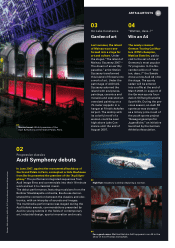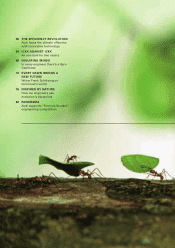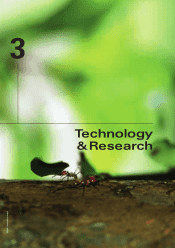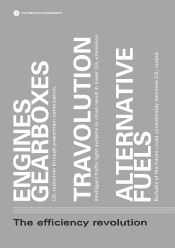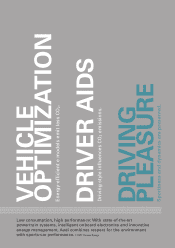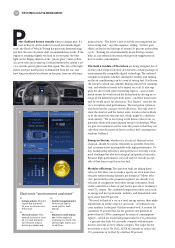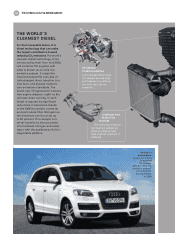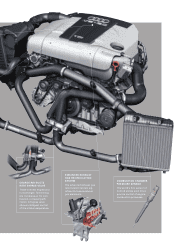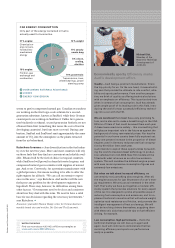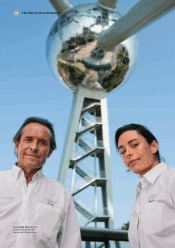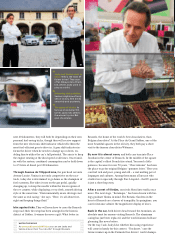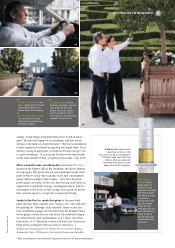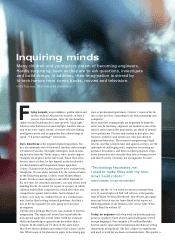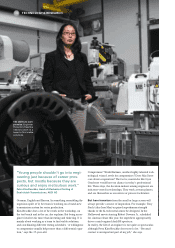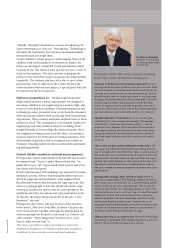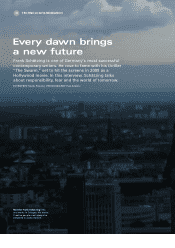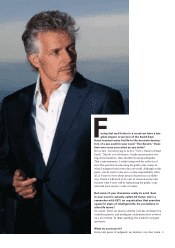Audi 2007 Annual Report Download - page 65
Download and view the complete annual report
Please find page 65 of the 2007 Audi annual report below. You can navigate through the pages in the report by either clicking on the pages listed below, or by using the keyword search tool below to find specific information within the annual report.
seems to prefer compressed natural gas. Canadian researchers
are working on the first large-scale solution for a second-
generation substitute, known as SunFuel, while their German
counterparts are working on SunDiesel. Unlike first-genera-
tion biodiesels or ethanol, second-generation biofuels are not
obtained from fruit (something that raises the cost of food in
developing countries), but from straw or wood. During com-
bustion, SunFuel and SunDiesel emit approximately the same
amount of CO2into the atmosphere as the plants extracted
from the air beforehand.
Kutschera foresees a clear diversification in the fuel indus-
try over the next ten years. More and more countries will rely
on those fuels that they find are convenient and reliably avail-
able. Ethanol will be the fuel of choice in tropical countries,
while SunDiesel will prevail in densely forested regions, and
compressed natural gas in countries with supplies of natural
gas. And so on. Conversely, for a premium manufacturer with
a global presence, this means needing to be able to offer the
right engines for all fuels. “We can call on extensive experi-
ence in this area,” says Kutschera. And neither will the new
fuels pose any problem for the development engineers in
Ingolstadt. There may, however, be difficulties arising from
other factors. “Governments need to be clear and consistent
about how they deal with this issue. We need to have a solid
base for our decisions regarding the necessary investments,”
says Kutschera. •
Economics journalist Thomas Ramge writes for German business
monthly brand eins and weeklies Die Zeit and The Economist.
/////////////////////////////////////////////////////////////////////////////////////////////////////////////////////////
/////////////////////////////////////////////////////////////////////////////////////////////////////////////////////////
/////////////////////////////////////////////////////////////////////////////////////////////////////////////////////////
/////////////////////////////////////////////////////////////////////////////////////////////////////////////////////////
/////////////////////////////////////////////////////////////////////////////////////////////////////////////////////////
/////////////////////////////////////////////////////////////////////////////////////////////////////////////////////////
WATCH THE MOVIE
Find out more about AUDI AG’s efficiency strategies at
www.audi.com/ar2007/efficiency.
Economically sporty. Efficiency marks
Audi’s development effort.
Michael Dick,
Member of the
Board for Technical
Development of
AUDI AG
Quality – Audi being a premium manufacturer, this is
the top priority for us. On the one hand, it means build-
ing cars that provide the ultimate in ride comfort, relia-
bility and sporty performance. From another perspec-
tive, we think of quality as offering technical solutions
with an emphasis on efficiency. This is particularly true
when it comes to fuel consumption. Audi has already
given ample proof of its leading role in this field, intro-
ducing the world’s most successful efficiency technol-
ogy into a car with the TDI.
We are convinced that diesel has a very promising fu-
ture, and is also set to make a breakthrough in the USA.
Billions of liters of fuel could be saved there each year
if diesel were used more widely – this is something that
will play an important role in the future as against the
background of rising raw material prices. Nor has the
potential in our home country been fully explored yet:
Every one percent increase in the proportion of diesel
engines used in Germany reduces total fuel consump-
tion by 90 million liters each year.
Audi intends to exploit these opportunities by launch-
ing the world’s cleanest diesel technology in produc-
tion vehicles from mid-2008. New TDI models will be
fitted with what is known as an ultra low emission
system. This will combine the hallmark engine power
with even more impressive consumption figures and
extremely low emissions.
But when we talk about increased efficiency, we
are certainly not just talking about engines. After all,
the engine accounts for just 50 percent of a car’s ener-
gy requirement. We are just as interested in the other
half. That’s why we have put together a modular effi-
ciency system that provides solutions for every aspect
of the car. It is designed to probe all possible ways of
reducing fuel consumption and emissions, and to im-
plement technical innovations that will reduce weight,
optimize road resistance and friction, and promote the
intelligent management of heat and energy. We will
also be involving drivers themselves, supplying them
with electronic aids that provide tips on fuel-efficient
driving, for example.
Low consumption, high performance – that’s the
technical challenge we will rise up to again and
again. Audi will continue to demonstrate that har-
monizing efficiency and sports-car performance
really is possible.
CAR ENERGY CONSUMPTION
Only part of the energy contained in fuel is
actually used for locomotion.
19% powertrain:
Transmission, tires,
wheel bearings, power
steering pump
11% aerody-
namic drag
12 % weight31% engine:
Chemical en-
ergy is trans-
formed into
mechanical
energy
19% engine:
Friction, gas
exchange and
combustion
OVERCOMING EXTERNAL RESISTANCE
LOSSES
ENERGY CONVERSION
CA
A
B
C
8% aircon,
cooling,
electrics
B
Photos and illustrations: AUDI AG
////////////////////////////////////////////////////////////////////////////////////////////////////////////////////////
////////////////////////////////////////////////////////////////////////////////////////////////////////////////////////
////////////////////////////////////////////////////////////////////////////////////////////////////////////////////////
////////////////////////////////////////////////////////////////////////////////////////////////////////////////////////
////////////////////////////////////////////////////////////////////////////////////////////////////////////////////////
////////////////////////////////////////////////////////////////////////////////////////////////////////////////////////


